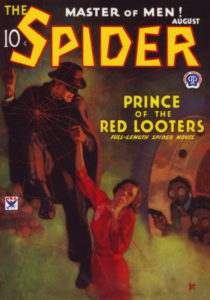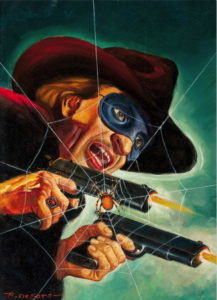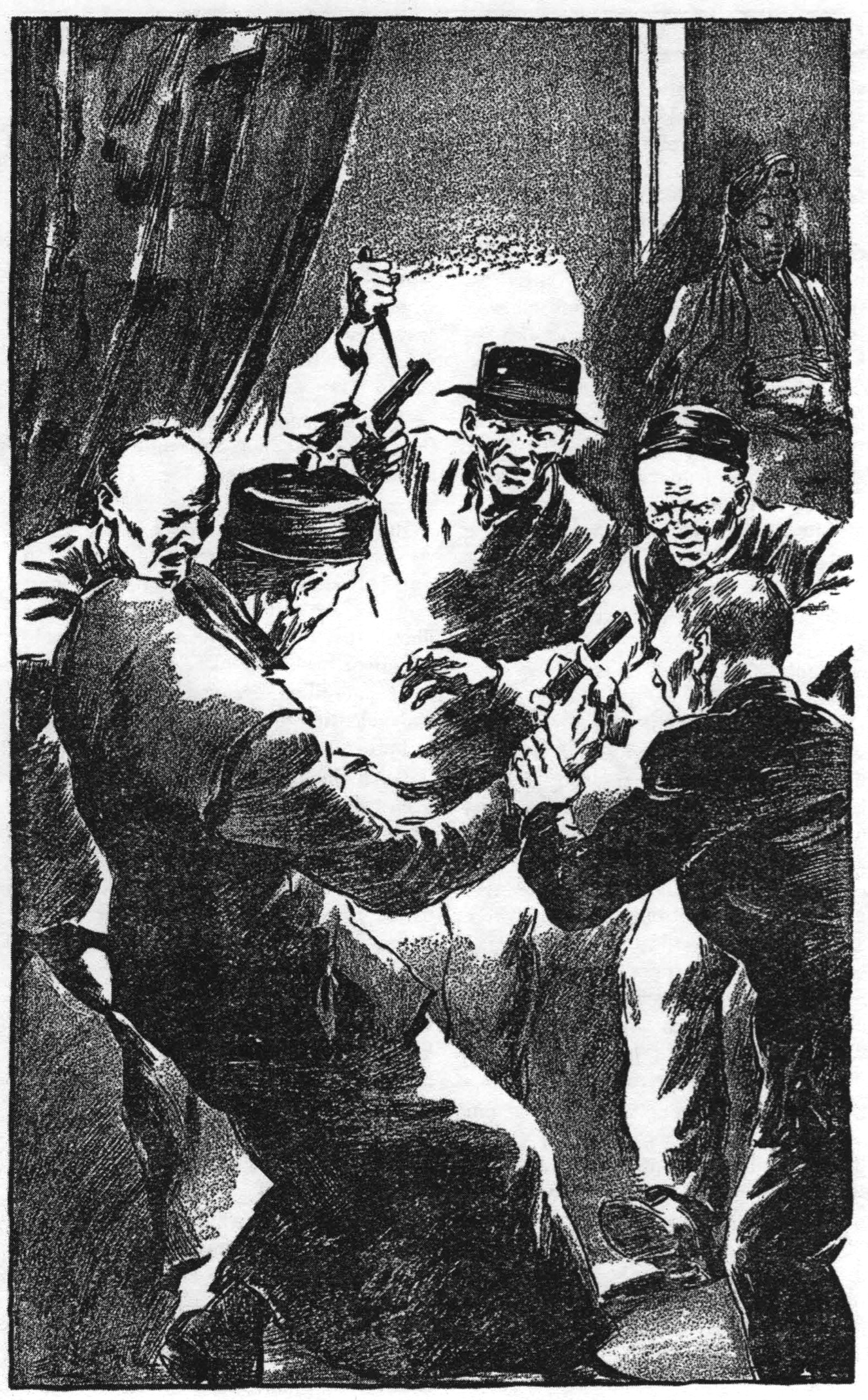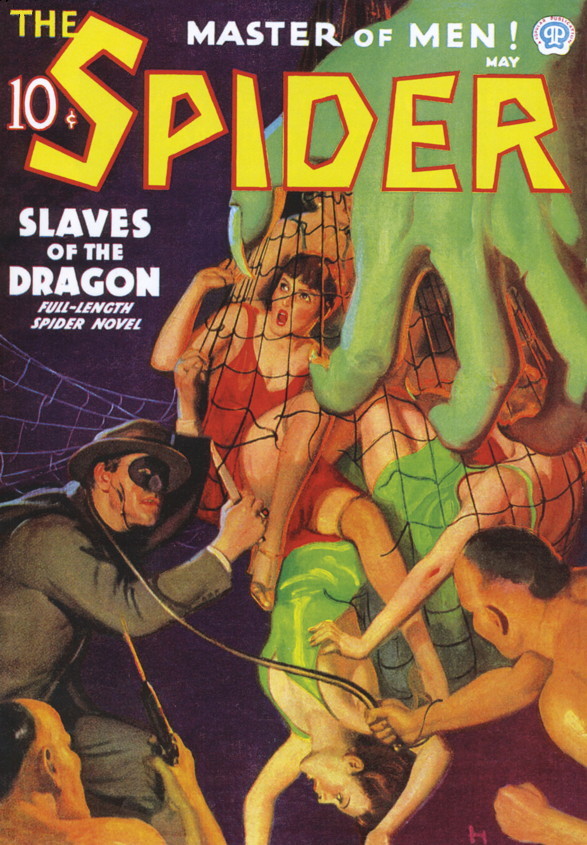
“Prince of the Red Looters” was originally published in the August 1934 issue of The Spider magazine. Never before had any criminal dared give open challenge to The Spider! Never before had Richard Wentworth faced a foe who welcomed personal combat with the grim avenger whom all others feared. And while they fought — The Spider and The Fly — a new and fearless criminal army was forming. “Kill The Spider — and the world is ours!”
This is not one of the best; it’s not one of the worst. It’s a perfectly respectable Spider novel, but it lacks the over-the-top action and the crazy death devices of some of the best Spider stores. The worst that happens is people die by phosgene gas. They don’t turn into withering zombies; there is no melting flesh; no poisonous vipers released upon an unsuspecting city. There is no rampant paranoia seen in some of the best Spider tales. Here, the police can be trusted. Government is not corrupt. Instead, we see The Spider confront a mastermind who is his equal. But since we’ve seen that before, in so many pulp stories, there’s not much to raise this story about the level of the rest. So, while it’s good… it’s enjoyable… it’s not among the best.
A new master criminal has risen calling himself The Fly. He had killed four men in an insurance office and had walked away with $50,000. He has challenged The Spider in a newspaper advertisement. “Won’t you come into my parlor?”
The Fly’s invitation
Richard Wentworth intentionally enters a trap set by The Fly. Seems that a showgirl, Rosetta Dulain, announced to the papers that she knew the identity of The Spider. She didn’t, of course. So Wentworth disguises himself as a milkman and makes his way into her building, past the police who are waiting to catch him. Once inside, he meets, for the first time, The Fly, who challenges him to a duel with sabres. Luckily, Wentworth is an accomplished swordsman. There is a furious battle between the two evenly-matched sword masters.
This is obviously one of those “gentleman” crooks. He plays by “sporting” rules. The Fly loses his sabre, and pulls a gun on The Spider. But he can’t bring himself to shoot the man. Wouldn’t be cricket, you know. So he has Rosetta Dulain tie up The Spider with his own silk webbing, then the two leave The Spider for the police, who are always anxious to catch their nemesis.
Rosetta returns and releases The Spider, and helps him elude the police. He’s not convinced that she’s on his side; he figures she’s trying to worm her way into his confidence so she can betray him to The Fly. The Spider’s trust is hard earned.
The police are out to get The Spider, and I don’t just mean the usual antics of Police Commissioner Stanley Kirkpatrick. The city has a new reform mayor, one W.O. Purviss. Purviss has appointed a new special deputy commissioner of police, Holland (no first name), whose sole job it is to capture The Spider. He’s assisted by chief Inspector MacTivish. Boy, The Spider better watch out, now! He’s got enemies everywhere.
The Fly isn’t in it for the money. He’s a dilettante playboy who is bored and has embraced crime for the thrill of it. The Fly carries a gentlemanly appearance. He had been born and reared rich, but luxurious ease had bored him. He has decided upon crime for its thrill. He has no concern for those who might suffer for his amusements. He wants to become ruler of the Underworld.
The Fly’s next job is his biggest. He robs the Race National Bank of a million dollars. He visits the bank in disguise as a customer. He grabs the bank vice president and heads for the vault where he fills a bag with dough. In leaving the bank, he shoots four customers, sets off the alarms, and sends the crowds fleeing into the streets. Meanwhile, he heads up the elevator to the 20th floor.
There, he switches clothing, puts the money in a stack of manila envelopes, and drops the cash-filled envelopes in the mail chute. He makes good his escape.
Meanwhile, Wentworth is strolling down the avenue and hears the alarms going off. He runs to the bank, figures the robber is still somewhere in the building, and discovers a stranded elevator with the dead vice president, a knife in his chest. The hilt of the murderous knife was tipped with a golden fly. The symbol of a new threat to New York!
The latest mastermind has escaped. The law is suspicious of Wentworth. He has reported a description of the perpetrator; how did he know? Special deputy commissioner Holland suspects that Wentworth knows more than he should. Suspicions are raised.
At police headquarters
Wentworth goes to police headquarters to Kirkpatrick’s office. There, the mayor is asking for his resignation. Purviss expects it within the hour, because Kirkpatrick apparently knew about the bank robbery in advance and did nothing about it. The evidence is a notation on a pad of paper, but it’s all a frame-up. Holland shows up. He’s angry with the mayor. He threatens to resign. Kirkpatrick convinces him to stay, and if offered the job, to take the commissioner’s job… to try to find out why Purviss is so anxious to get Kirkpatrick out. Holland wonders if Purviss could be The Fly.
There are plenty of suspects to go around. All of them are intelligent, have amazing skill at swordsmanship, and happen to be in the area when The Fly appears. There’s Joe Stull, a witness who claims to have seen The Fly in the bank. There’s mayor Purviss. There’s MacTivish, the inspector. There’s Fred Cook, an ex-racketeer who claims he’s now straight. These suspects keep popping up in the wrong place at the right time, and it keeps the readers guessing who the hidden master of crime could be.
Attempts are made on Wentworth’s life. Apparently, The Fly has pierced The Spider’s secret identity. A car speeds by, spewing machine-gun bullets at our hero.
We meet young Corcoran Kirkpatrick, the police commissioner’s nephew. He’s in love with Ginnie Clark, sister of Rosette Dulain, The Fly’s moll. As the story progresses, he’s put in harm’s way along with his paramour Ginnie.
When Ginnie is kidnapped by The Fly, her sister Rosetta Dulain goes to Wentworth for help. Somehow, The Fly has penetrated his identity, and sent Rosetta to him to insinuate herself in his confidence. The Spider wants to help, but is wary.
The following morning, The Fly is preparing to strike again. He has used his million dollars to mail out gifts of loot to gangsters. He now has half a hundred men eager to do his bidding. The sack of Fifth Avenue is only one a half-dozen robberies his fertile mind has mapped out. More bank robberies. Jewelry store robberies. Armored truck robberies. All leaving blood-spattered crime scenes in their wake. Fifty… 100 innocent lives taken by gunshot and poison gas. The Fly has formed a huge criminal organization that will wreak havoc upon the city.
Next to be struck: the opera! The Fly warns The Spider not to interfere. But our hero does, of course, and the results are fatal for another 50 or so innocent souls. And there is more carnage to come!
It all ends with a terrific unmasking of the villain in his lair, and one final amazing sword fight in which The Spider finally wins the day. And The Fly is dead. Well, actually, he only seems dead. Somehow, he will return a year-and-a-half later in the 1936 story “Green Globes of Death.” How they explain away his demise in this tale is something you’ll have to read for yourself.
And then there are disguises…

There are plenty of Wentworth disguises to go around in this fun romp with The Spider. He becomes “Gus,” a thug whom he has captured. Using this identity, he is able to infiltrate the mob. Once inside the gang’s headquarters, he changes his disguise to that of… The Fly, himself! That makes for a pretty cool scene, when the real Fly encounters The Spider in disguise. There are two of them. And they each have to convince the gang of cutthroats that the other is the impostor.
I really loved the climax of the story where dirigibles were flying above the city, preparing to aid in the robbing of four banks at once. Army airplanes are called in to attack, and The Spider, on the roof of one of the banks, gets to reel in one of the dirigibles, himself!
We get to see Ram Singh in action, as he gets a large role in this story. That’s definitely a plus. He’s quite a ferocious fighter. Nita doesn’t have much to do in this tale, but appears a few times. Jenkyns has basically a walk-on role. And Jackson is only mentioned briefly in passing, once.
You know the web of The Spider? It’s a special silk cord of his own invention. In this story we’re told that is scarcely as thick as a lead pencil, yet it has tested to several hundred pounds. Now that’s pretty impressive even by today’s standards, much less by 1934 standards.
Readers learn that The Spider keeps a compact tool kit strapped beneath his arm. Among other tools, it contains a lockpick, which often comes in handy. There are other tools as well in this small case, but no others are specifically mentioned, here.
Again, we see the neatly hung wardrobe hidden in the back of his limousine. The left side of the rear seat slides forward, revealing clothes and Wentworth’s disguise kit. I think I’d like to have a car like that!
The story reminds us that Wentworth is a master of both the violin and the organ. He has a mighty organ that fills the large duplex room of his home. (Okay, quit snickering. You know what I mean.)
One thing that continues to puzzle me is the title of the story. The Fly is definitely the “Prince of Looters.” But what’s with the “Red” description? There are no red costumes in this story. The looters don’t have red skins. And no hint of Communism, either. About the only red thing in this story is the copious amounts of blood spilled, but that’s hardly unique to this story alone. If blood were the criteria, then all of The Spider stories would have to be so named. So the title “Prince of the Red Looters” seems to be chosen almost at random. Maybe just because it sounded good? I can’t figure any other reason.
The verdict
I think you’ll like this story. But probably you won’t love it. The Fly is a clever and wily opponent, but in the end, as expected, The Spider outwits him. It makes for a very satisfying end. It also makes for a Spider tale that you’ll enjoy. Because… that’s pulp!



Hi, John! I agree that this was a middle of the road tale as far as Spider stories go. Still, it had some fun moments. I was also puzzled by the title. Perhaps the editor thought an adjective was called for and pulled one out of thin air. The only red on the cover is the woman dress, I guess the “Prince” wanted to “loot” her attire 😉